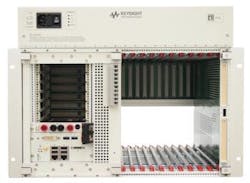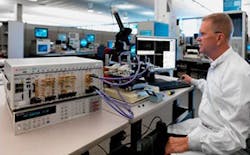Test Efficiency and Accuracy—But at What Cost?
The same day I read through the 2015 Electronic Design Salary Survey I had one of my semi-regular update chats with Keysight Technologies. This time we focused on its PXI/AXIe offerings and it was almost like it had predicted the survey and its theme of rapid evolution of technology giving designers test headaches, while also addressing a fundamental user shift toward modular test solutions.
While there’s no need to worry that the famously messy desk of the beloved Jim Williams (RIP) will disappear entirely, the advantages of modular, combined with massive levels of integration and narrowing time-to-market windows have brought about a shift in approaches to test equipment that may prevent such desks from being overrun entirely.
Some of the key takeaways from this year’s survey include time-to-market pressures leading to the inability to adequately test products due to time constraints—65% of you think testing is a significant challenge in terms of time consumption. It can’t be a coincidence, then, that 17% of companies have replaced box-test instruments with modular solutions, the most popular of which is PXI.
Modular has many advantages over box or benchtop equipment, not least is the ability to more quickly upgrade as test needs multiply and change. As Jim Armentrout, head of global sales and marketing for Keysight Technologies’ Modular Solutions group, pointed out, the Internet of Things (IoT), combined with the always accelerating levels of integration, turn even mundane consumer devices, such as TVs, routers, and home automation devices, into big challenges when it comes to test, for both hardware and software.
However, Keysight didn’t make its name by targeting mundane applications: its strength and its differentiation comes from solving the biggest, most technically challenging test problems, like 5G, which is so big we don’t even know what it looks like yet! We have hints, like PAM5 signaling, and massive, multi-user MIMO, but despite the hoopla, the full spec won’t be ready until at least 2020.
In the meantime, test and measurement investments must be made, so modular becomes attractive as a means of addressing high turnover and uncertainty. Keysight is counting on this, and while modular currently comprises a scant 8% of the overall test and measurement market, and that market is growing at 15% per year, versus 2% or 3% for other equipment. That should tell you a bit about what your next equipment purchase will look like.
Keep the Family Happy
What the Salary Survey didn’t address were the technical test challenges that keep designers up at night. Was my equipment calibrated recently? Is it accurate enough? Precise enough? Will it integrate with my current setup? Will my spouse/partner/kids/dog get mad if I sneak back to the lab for one more test run?
While it may not say so explicitly, Keysight is actually in the business of keeping families happy and stress-free. Its move into modular test has targeted the most frightening of applications, focusing on the highest-performance microwave and RF requirements in manufacturing, R&D, and validation.
Just this week the company is introducing the M9393A, the first 50-GHz PXIe vector signal analyzer, as well as the U8989A, a reference solution for automotive electronics.
The M9393A sweeps continuously from 3.6 to 50 GHz and has a displayed average noise level (DANL) of -155 dBm/Hz at 40 GHz and with accelerated sweep. It comes with full 89600 VSA software support and is extensible, including the number of channels, analysis bandwidth, and memory. With regulatory EMI searches requiring large spans and narrow-resolution bandwidth to maximize the dynamic range for location of very-low-level signals, the M3393A excels in spur detection and low-noise floors.
The automotive reference solution is for body and safety electronic control unit (ECU) functional verification and test. With a large number of input signals from various sensors, including force, position, and discrete switches, the U8989A provides 24 channels per card, with each able to handle up to 2A. The load card can handle up to 40A and includes current-sense capability.
The two PXI boxes follow quickly on the heels of the M9485 PXIe multiport vector network analyzer and M8196A arbitrary waveform generator that Keysight announced in September, as well as the M9709A 8-bit high-speed digitizer it let loose last May, and it’s likely that Keysight isn’t done yet for 2015.
While I’m pretty sure modular equipment won’t be completely overtaking the benchtop any time soon, I asked a friend of mine, Larry Desjardin of Modular Methods, what impact he thought modular would have on desks like Jim Williams’.
Never one to miss a chance to joke around, he pointed out that it would be hard to get rid of soldering irons and tools boxes using a modular approach, but added, “I think there is a good chance of reducing the instruments on his desk to one or two PXI crates, plus a laptop.”
Larry went on, saying, “A lot of the gear [on Jim’s desk] looks older vintage and would be smaller even as traditional instruments if done today. PXI (or AXIe) will give even more space savings by eliminating the front panels and displays, with that functionality delivered via software running on a laptop or desktop computer.”
Larry’s right, of course, which is why I asked him, but I think what may be overlooked a bit is the attachment we have to scopes or analyzers we know inside and out, despite their performance limitations and often even despite their quirks and aberrations too. What would Jim or Bob Pease say? What would you hold onto, no matter what?
About the Author
Patrick Mannion Blog
Founder and Managing Director
Patrick Mannion is Founder and Managing Director of ClariTek, LLC, a high-tech editorial services company. After graduating with a National Diploma in Electronic Engineering from the Dundalk Institute of Technology, he worked for three years in the industry before starting a career in b2b media and events. He has been covering the engineering, technology, design, and the electronics industry for 25 years. His various roles included Components and Communications Editor at Electronic Design and more recently Brand Director for UBM's Electronics media, including EDN, EETimes, Embedded.com, and TechOnline.




